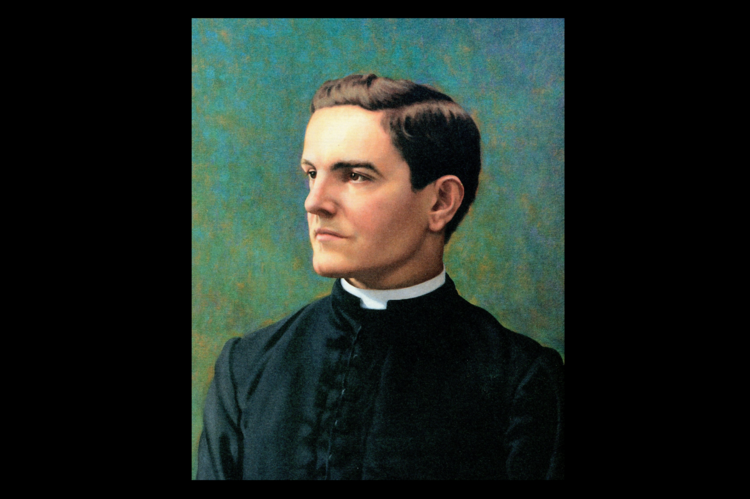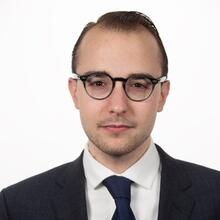The Catholic Church is often depicted as a monolith: a single, worldwide institution with a high level of centralization, and with prayers and orders scrupulously sent down from on high. Yet it is at the local level that the church has its greatest impact—feeding the hungry, caring for the sick and the dying, accompanying people through the heights of their joys and the depths of their sorrows. It is also the level historically best equipped to respond to new challenges within local communities, whether it be with educational institutions, orphanages, hospitals, farming collectives or numerous and varied other ways that the church meets the world.
Perhaps one of the most notable instances of a local solution to a local problem becoming an international movement is the Knights of Columbus, whose founder, Father Michael McGivney, was beatified on Saturday, Oct. 31, at the Cathedral of St. Joseph in Hartford, Conn. It is important to understand how Blessed McGivney’s response to a local issue laid the foundation for millions to engage in service and charity around the world over the last 138 years.
The Origins of the Knights of Columbus
The late 19th century, marked by advances in technology, science and industry, was nonetheless a dangerous time for workers. In New England, for example, several generations of the same family often worked in mills for 12 hours a day, six days a week. There were few, if any, social structures to help those who were injured while at work and little to no support for those who lost a loved one. The loss of a father in an industrial accident was particularly devastating for the family and its livelihood; men were paid more and could easily find work in the mills, whereas women and children were relegated to more specific (but nonetheless dangerous) tasks for less pay. Even when someone was injured at the fault of the owner, there was little to no recourse in the law.
Blessed McGivney’s response to a local issue laid the foundation for millions to engage in service and charity around the world over the last 138 years.
Of course, while industrialization was a key component of growth in the United States in the late 19th century, so was the immigrant population that helped to provide workers for these mills and factories. According to the Library of Congress, nearly 12 million immigrants came to the United States between 1870 and 1900. For decades before this period, and into the present day, there were currents of strong anti-immigrant rhetoric throughout American society, notably embodied by the nativist movement of the mid-19th century. This aggression toward immigrants was frequently justified by the perceived differences between those already on America’s shores and those who sought to come. Religion played a major role in the attacks leveled by nativists, who especially marked Catholics as anti-American for their “allegiance” to the pope.
It was in this environment that Michael J. McGivney, a young Catholic priest at St. Mary’s Church in New Haven, Conn., gathered a group of men in the parish to create a society to, as the Knights’ website now says, “prevent Catholic men from entering secret societies antithetical to Church teaching, uniting Catholic men and helping families of deceased members.”
Who was Father Michael McGivney?
Michael J. McGivney was well suited to organize such a society because he knew of the family strife caused by the loss of a father. McGivney was born in 1852 in Waterbury, Conn., the first born child of Patrick and Mary McGivney. After graduating from school at the age of 13, McGivney, like so many of his peers, went to work in a brass factory to earn money for his family.
At the age of 16, McGivney left Waterbury for Quebec, there entering the seminary at the College of St. Hyacinthe. He continued his studies at Our Lady of Angels Seminary in Niagara Falls (now Niagara University) and St. Mary’s Seminary in Montreal. In 1873, his father, Patrick McGivney, died, and Michael had to leave his priestly studies to help support the family. Fortunately, Bishop Francis McFarland of Hartford offered financial support to the family and gained admittance for McGivney to St. Mary’s Seminary in Baltimore.
[Their baby had no chance of survival. So they prayed to Father McGivney for a miracle.]
McGivney was ordained by Archbishop James Gibbons (later made a cardinal) in December 1877 in St. Mary’s Cathedral in Baltimore. He was assigned as a curate at St. Mary’s Church in New Haven and there gained a reputation for his care and concern for parishioners. One such parishioner noted: “He was a man of the people. He was zealous of the people’s welfare, and all the kindliness of his priestly soul asserted itself more strongly in his unceasing efforts for the betterment of their condition.”
It was here, in 1882, that Father McGivney formed the Knights of Columbus. The goal of the group was to care for the poor and the widowed, to make its members better Catholics and better Americans, and to contribute to the spiritual and civic well-being of the church and the local communities of its members. It was a response, under Father McGivney’s leadership, to the anti-Catholic sentiments and industrial abuses of the era in which he lived.
“[Father McGivney] was zealous of the people’s welfare, and all the kindliness of his priestly soul asserted itself more strongly in his unceasing efforts for the betterment of their condition.”
Father McGivney’s early ministry was so successful that he was made pastor of St. Thomas Church in Thomaston, Conn. It was while he was at St. Thomas that the Knights of Columbus began to grow, receiving a charter from the state legislature in March 1882. The order’s original goals, according to Father McGivney, were unity and charity. He explained in a letter, “Unity in order to gain strength to be charitable to each other in benevolence whilst we live and in bestowing financial aid to those whom we have to mourn.”
After six years as pastor of St. Thomas, McGivney contracted tuberculosis and eventually succumbed, at the age of 38, to the disease in August 1890. Widely mourned, his death did not signal the end of the Knights of Columbus, which because of its structure as a lay, fraternal organization (as devised by McGivney), could carry on its work after his death.
Over 100 Years of Service
Since the founding of the Knights of Columbus, millions of men have joined their ranks. By the end of its first decade, the Knights counted nearly 6,000 men among their membership. In 1910, the Knights had councils operating throughout the United States, Canada, Mexico, the Philippines, Cuba and Panama, and had opened its first college council at the University of Notre Dame.
Almost from the beginning, the Knights were engaged in a variety of civic and philanthropic activities. Between 1909 and 1913, the Knights raised $500,000 to offer a permanent endowment to The Catholic University of America. During the First World War, the Knights contributed greatly to the war effort, organizing “K of C Huts” throughout the United States and Europe, offering hospitality, religious services and recreation. After the war, the Knights sponsored evening school programs for more than 50,000 veterans. During the Second World War, the Knights offered similar services to service members and established a $1 million fund to support the families of those who lost loved ones.
Since the founding of the Knights of Columbus, millions of men have joined their ranks.
In the second half of the 20th century, the Knights made significant contributions to the completion of the National Shrine in Washington, D.C., funding for the “uplink” of transmissions for worldwide satellite telecasts from the Vatican, establishing the McGivney Fund for New Initiatives in Catholic Education in partnership with the National Catholic Educational Association, and underwriting the restoration of the facade of St. Peter’s Basilica in Rome. The Knights have sponsored, in some form or another, the recent papal visits to the United States.
In recent years, the Knights have given support to victims of, and first-responders to, the terrorist attacks on Sept. 11, 2001, and to the survivors of Hurricane Katrina and the 2010 earthquake in Haiti. The organization has given support to persecuted and endangered Christians in the Middle East. The Knights are also significant leaders in the pro-life movement, donating over 500 ultrasound machines to pregnancy clinics.
The Knights Today
As of 2020, the Knights of Columbus has 16,424 councils worldwide, comprising over two million members. Even though these councils are stretched far across the world and the membership is diverse, the Knights’ central goals have varied little since 1882.
The order continues to contribute millions of dollars each year to academic and vocational scholarship programs, including nearly $5 million in disaster relief in the last year, $25 million to support those who live in regions affected by ISIS and nearly $150 million more in other charitable contributions.
This is all supplemented by 77 million volunteer hours of work within the last year in communities throughout the world, at an estimated value of $2 billion.
Modern Controversies
The last 138 years have not been without controversy. In recent years, the Knights have come under scrutiny for how they disburse their funds vis-à-vis political contributions. In light of this, questions have been raised about the general state and transparency of the Knights’ finances and where monies are being donated outside of the organization’s charitable giving.
Perhaps one of the most notable controversies in recent years has been around the very name of the organization. In light of the Black Lives Matter movement and the groundswell around matters of race and national reconciliation, there have been calls to have the organization renamed. The organization draws its name from Christopher Columbus, whom Father McGivney chose as the patron of the order to emphasize both the Catholic and American nature of the organization. Columbus’s legacy has come under increasing scrutiny in recent years, especially as it relates to the inhumane treatment of indigenous peoples under Columbus and the European colonists who followed him.
Father McGivney could have hardly imagined that his fraternal, lay mutual benefit society would grow to such a degree that it now includes millions of members in every corner of the globe; from a small parish group to, at one point, owning the land under Yankee Stadium, hosting papal Masses in the United States and maintaining over $100 billion in its life insurance policies. The success and prevalence of the Knights of Columbus is a testament to the efficacy of the care and concern of a parish priest brought to a national scale.
More Stories from America:
– Their baby had no chance of survival. So they prayed to Father McGivney for a miracle.
– Explainer: Where did Halloween come from? (And should Catholics celebrate it?)
– Blessed Carlo Acutis watched ‘Pokémon.’ That’s my kind of saint.
– The first African-American cardinal is a tribute to the faith of Black Catholics—and a gift to the entire church








